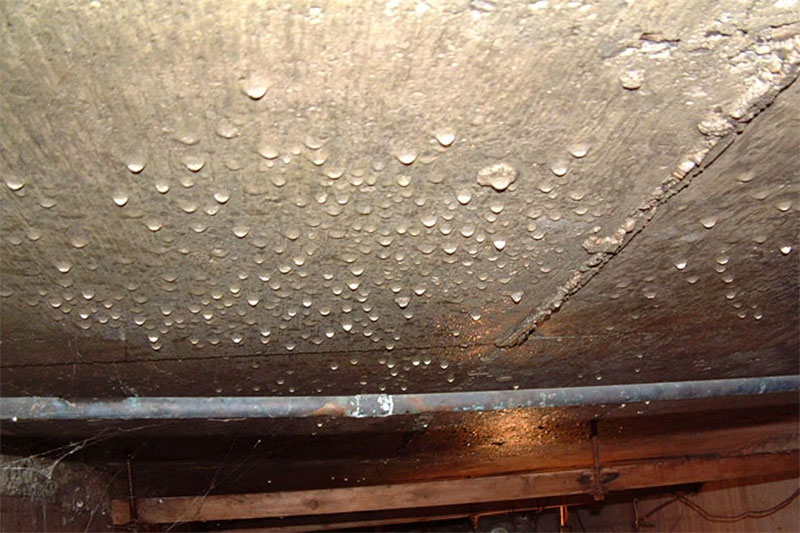#1. An Interior Plumbing Leak
This may seem like a no-brainer, but you should always check for inside leaks first when trying to identify the cause of moisture in your basement. A water leak can come from numerous places: a shower, a sink, a toilet, a washing machine, a dishwasher, a bad pipe, just to name a few. Sometimes, if the moisture in your basement is located on the ceiling or walls beneath a bathroom or kitchen, an interior water leak is to blame. Find where the moisture is located and determine if something in that area is leaking.
How to Fix It: An interior leak is typically one of the easiest problems to solve. Simply repair the leak (or have a plumber take care of it for you) and with any luck, that was the cause of the moisture, and it will be gone for good. Chances are if you have a leak you may also have mould.

#2. Ineffective Grading
Rain or groundwater often makes its way into basements due to improper grading. The ground around your foundation should slope away from the house, not towards it. If draining in the wrong direction, water will accumulate against your foundation and eventually make its way inside. This often happens when fill dirt around your foundation isn’t properly compacted. As the dirt settles, the slope changes and water flows toward your house rather than away from it. Sidewalks are a problem too as sometimes the settle towards the home which literally directs water between the sale and foundation wall.
How to Fix It: Build up the dirt around your foundation, creating a slope aiming away from the house. This should be a minimum of one inch per foot, for at least 6 feet. If your concrete is sloping you can have that lifted up for you as well.

#3. Missing or Defective Gutters and Downspouts
The purpose of gutters and downspouts is to direct rainwater away from the foundation of your home. If those gutters and downspouts are missing, or not functioning properly, rainwater is often directed towards your foundation. As water drains toward your house, it can accumulate in the soil around it. If water accumulates around your foundation, chances are, it will make its way inside into your basement.
How to Fix It: Consider adding gutters if there are none already in place. A minimum of 1 downspout should be placed per every 50 ft. of the roof eave. Extenders should be placed on all downspouts, dispersing water at least 4 ft. away from the foundation. Existing gutters should be cleaned regularly to ensure they are functioning properly. This should always be completed before considering a basement waterproofing project.

#4. Cracks in Your Foundation
If you have cracks in your foundation, you can be sure that water will find them and make its way into your basement. In fact, sometimes the water is even the cause of the cracks themselves. If floor joists are not properly connected to the foundation walls, it can allow the walls to move, and in turn, cracks are formed. Water can actually cause cracks in the foundation as well due to poor drainage in the soil.
If water is not directed away from your foundation and accumulates against the foundation walls, and that pressure (hydrostatic pressure) can force the water into the walls, creating cracks. No matter how the cracks formed, if they exist, water can enter your basement through them. Cracks should always be repaired even if they don’t leak!
How To Fix It: Depending on the cause of the cracks, your solutions will vary. If hydrostatic pressure (due to water accumulating around the foundation) is the cause of the cracks, repairing your exterior drainage should help to solve the problem. The cracks will still need to be repaired, but the cause should have been repaired. If structural problems caused the cracks,a proper wall repair system should be installed.

#5. Poor (or Missing) Drain Tile and Sump Pit
Many houses do not have a subsurface drainage system. Basements in older homes often were not intended to be habitable spaces, thus an under-the-floor drainage system wasn’t necessary. More modern homes that do have a drainage system often experience problems with their system. This can range from a clogged pipe, broken connection, or a broken sump pump.
How To Fix It: Unfortunately, problems with your subsurface drainage system, or adding one where there wasn’t one. If you think this is where your problem lies, its best to call in the professionals. It involves digging up your flooring and adding a drain system, which leads to a pump that will expel any moisture. Building, or repairing a subsurface drainage system is a complex task, best left to experts with tools and knowledge to get the job done right the first time.

#6. Condensation
Basement condensation occurs when warm, moist air comes in contact with your cool basement walls and floor. As the walls cool the warm air, moisture is created, just like condensation on a cold beer on a hot summer day. You’re in luck if the moisture in your basement is coming from condensation, rather than a leak or drainage problem, as these issues are typically much easier and less expensive to resolve.
How To Fix It: The best way to deal with condensation is to install a high performance de humidification system. Hardware store ones are ok but at Supreme we install commercial grade machines that are energy efficient and actually work.

Not always does a wet basement involve needing a waterproofing to be installed. But always a wet basement is an unhealthy space. So if you think you have any moisture problems in your basement please reach out to us to schedule a free no obligation inspection!

